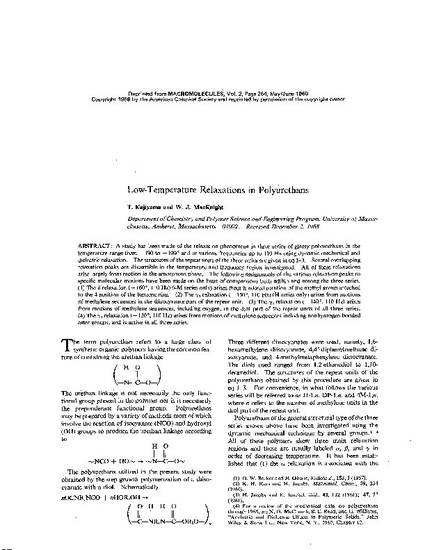
Article
Low-Temperature Relaxations in Polyurethans
Macromolecules
(1968)
Abstract
A study has been made of the relaxation phenomena in three series of glassy polyurethans in the temperature range from -190 to 100° and at various frequencies up to 110 Hz using dynamic mechanical and dielectric relaxation. The structures of the repeat units of the three series are given in eq 1-3. Several overlapping relaxation peaks are discernible in the temperature and frequency region investigated. All of these relaxations arise largely from motion in the amorphous phase. The following assignments of the various relaxation peaks to specific molecular motions have been made on the basis of comparisons both within and among the three series. (I) Theo relaxation { -160°, 110 Hz) {4M series only) arises from hindered rotation of the methyl group attached to the 4 position of the benzene ring. {2) The "Y• relaxation { -150°, 110 Hz) {H series only) arises from motions of methylene sequences in the diisocyanate part of the repeat unit. {3) The "Yz relaxation { -140°, 1 io Hz) arises from motions of methylene sequences, including oxygen, in the diol part of the repeat units of all three series. (4) The 1'1 relaxation {-120°, 110 Hz) arises from motions of methylene sequences including nonhydrogen bonded ester groups, and is active in all three series.
Keywords
- Temperature,
- Relaxations,
- Polyurethans
Disciplines
Publication Date
1968
Citation Information
William MacKnight and T. Kajiyama. "Low-Temperature Relaxations in Polyurethans" Macromolecules Vol. 2 (1968) p. 254 - 261 Available at: http://works.bepress.com/william_macknight/16/
